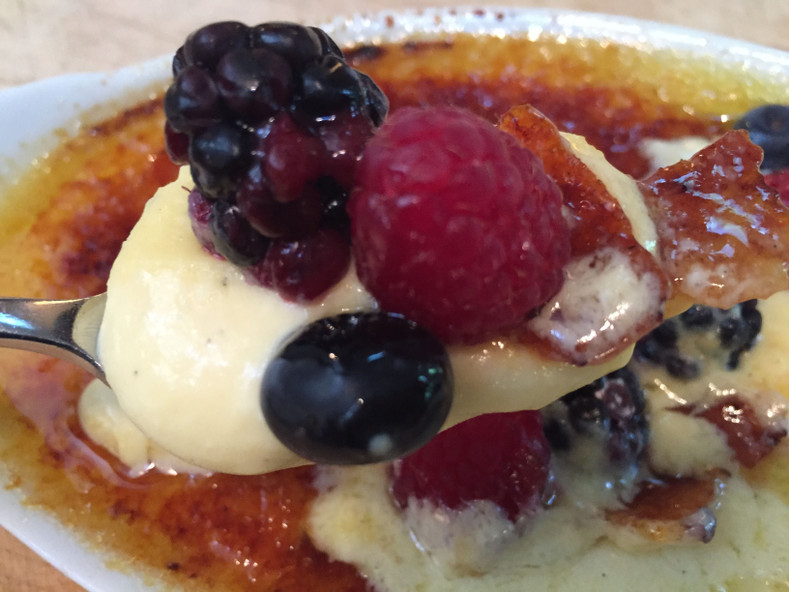Crème Brulée with Meyer Lemon and Vanilla Sous Vide

| With a name like Crème Brulée it would be easy to assume
that this seemingly classic French dessert might not be Gallic in origin at
all. As with so many recipes especially
those from the close confines of Europe it’s hard to verify origin. This vanilla
laced custard topped with a crackly caramelized sugar crust has documented
roots that seem to spread across the “pond” to Trinity College in Cambridge,
England which also claims to be the birthplace of the dessert - Mon Dieu! Known
there as a ‘burnt cream or Cambridge cream’, they actually burn the college
crest into sugar top using a hot iron branding iron. Then of course Spain has a version called
Creme Catalana that has been all the rage since the 18th century. Now here in the good ole U.S. of A it's not quite clear when the Crème Brulée hit our shores. That being said, there is a recipe for "Cream with Burnt Sugar" in my well-worn copy of Oscar Tschirky's ground breaking 1896 cookbook "Oscar of the Waldorf". Mr. Tschirky was the world renown Maître Di Hotel of the famous property and inked his equally famous gastronomic tome showcasing the recipes from the Waldorf hotel which was later to become the Waldorf Astoria that we know today. Yet for our purposes here I think 1982 is the year we should be aware of. For that is when Alain Sailhac the French born and trained chef apparently relaunched the Crème Brulée at the venerable and oh so French-y restaurant, La Cirque. As La Cirque was the most famous French restaurant of its time the public seemingly came to accept Crème Brulée as a truly French creation. |
|
It was in the early nineties that I began making and serving the famous dessert at my first restaurant. I can still remember seeing and hearing some of my patrons swatting the tops of their desserts, cracking the golden sugar crust, giggling and fascinated by the culinary pyrotechnics that it took to create such a unique dessert and in a strip mall of all places! |
| The classic French version is pretty straight forward and not all that difficult as it is - but sous vide makes it insanely easy. Yet at its heart it is a custard and that requires cooking egg yolks which does raise the anxiety factor for some. A bit too much heat or too much time can cause curdling. I’ll say it again, sous vide to the rescue! As in previous recipes the technique is as fool proof as it can get when making this at home and VacMaster has you covered. |
|
| I find when serving the dessert, it traditionally calls for a porcelain or earthenware ramekin. My tastes lean towards ramekins with a larger circumference and a shallow depth. That way, the rich sweet cream is balanced by the caramelized sugar in every bite. If you feel that 12 egg yolks is a bit too rich for your taste think about this while your SV1 lazily cooks those yolks to creamy perfection. The world record for largest Crème Brulée used 4000 eggs with 125 pounds of sugar, 115 gallons of cream, 19 gallons of milk and 1 gallon of vanilla extract. It topped out at 26 feet in diameter, weighing in a whopping 1,600 pounds with an estimated two million calories! |
Ingredients: • 4 whole Meyer lemons • 12 large egg yolks • 1-quart heavy whipping cream • 1/2 cup sugar • 1 tablespoon vanilla bean paste, high quality For finishing the brulée: • 1/2 cup sugar |
|
|
Directions: 1. Preheat the VacMaster SV1 to 85°C/185°F 2. Using a sharp paring knife or similar carefully cut into the skin and slide the knife around the lemon, angling the blade between the skin and the pith. 3. Continue removing the peels from the entire lemon and repeat with the remaining three, reserve the peels. 4. Combine the egg yolks, cream, sugar and vanilla bean paste in a bar blender or similar. 5. Gently blend the mixture until smooth and homogenized. 6. Using a the VacMaster Bag Filler and an appropriate sized VacMaster bag(s) add the cream mixture. 7. Add the reserved lemon peels to the cream. 8. Using a VacMaster chamber machine vacuum seal the bag keeping a careful eye on the mixture level as cream expands during the vacuum process. If the level rises too close to the seal bar, immediately press seal or stop to end the process. |
9. Carefully lower the bag into the SV1 and cook for 30-45 minutes or until the custard has properly thickened, agitating the bag every 15 minutes or so to prevent clumping. 10. Carefully remove the bag from the SV1 (it will be quite hot) remove the lemon peels and discard, then pour the contents into a pitcher or similar. 11. Using a whisk blend the contents thoroughly and divide the mixture up into 6 or 8 shallow 6-inch round baking dishes placed on a cookie sheet or tray. 12. Refrigerate for at least 4 hours and up to 12 hours or until the cream is cold and thoroughly set. 13. Remove from the refrigerator, and using a can style sugar shaker or similar dust the sugar evenly over the tops of the chilled cream, and glaze the sugar using a blowtorch or under the broiler for several seconds, until the sugar forms a firm crust, watching carefully to see that it does not burn too much. 14. Return the custards to the refrigerator to firm up the custard for about 15 minutes before serving. |
|







